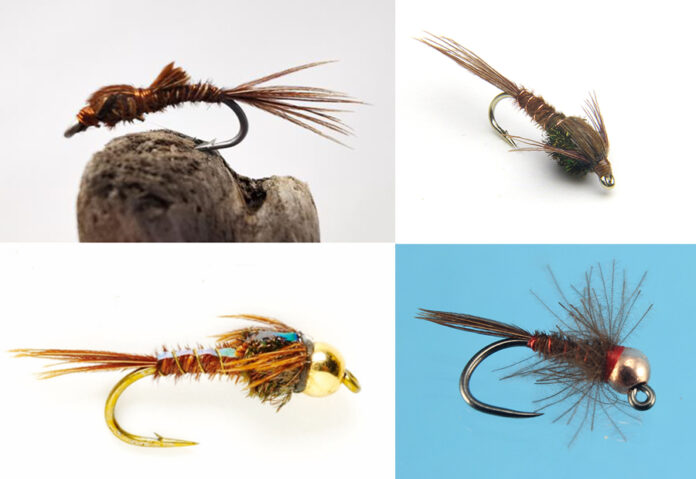Written By: Dave Brown, Dave Brown Outfitters
Last April, I booked a day on Nelson’s Spring Creek in Montana’s Paradise Valley, hoping to enjoy a textbook blue-winged olive hatch. Upon arrival, I rigged up with a yarn indicator, a weighted scud pattern, and then 12 inches below that a Pheasant Tail Nymph. The weather was perfect: snow squalls and clouds came in and out of Paradise Valley, which were perfect conditions for BWOs.
I walked down to the bottom of a riffle and then carefully waded out to get into a good casting position. After my first few drifts, I adjusted my indicator so I was not hanging up on the bottom as much, and then sure enough the indicator stopped and I was tight to a good rainbow trout. It was rinse and repeat for a while—with the size 18 Flashback Pheasant Tail getting the job done—until adult olives started to appear on a slow flat and the trout began to rise to the mayflies. A wonderful afternoon of dry-fly fishing ensued.

In early July, on a series of lakes and ponds on a ranch in Wyoming, a friend and I were having good success with small Simi Seal Leeches fished deep and slow. Toward evening, cruising trout began to feed just under the surface, and I noticed a few Callibaetis mayflies on the water. I quickly re -rigged to a size 12 Beadhead Pheasant Tail, which I cast to cruising trout who ate it as soon as I started a slow-strip retrieve. Once again, the P.T. provided nonstop action when presented properly. It’s a fly that consistently produces trout, in a wide variety of angling situations.
Origins
The original Pheasant Tail Nymph was created by the late English River Keeper Frank Sawyer in the 195os to imitate a variety of mayfly species found in English chalkstreams. His original version uses just two materials, Pheasant Tail fibers for the tail, abdomen, and wingcase; and fine copper wire for the ribbing, thorax, and head. In typical British fashion, Sawyer fished the Pheasant Tail upstream to sighted fish, and no doubt the selective trout of the River Avon pounced on it. Despite the shift to the more Americanized variants, the original pattern remains effective to this day.
The Pheasant Tail Nymph that most fly-fishers have come to know was a version tied by legendary Montana outfitter and fly tier Al Troth (best known for his Elk-Hair Caddis). He added a peacock-herl thorax and created legs by tying back the pheasant tail fibers before building the head. In more recent times, flash has been added by tying a strand of Flashabou for the wing case, resulting in the flashback Pheasant Tail. The advent of beads led to PT patterns with even more flash and weight. Other tiers use a CDC hackle tied in as a collar, thus adding more movement and downright sexiness. More recently, the jig-hook revolution has included the Pheasant Tail, a favorite amongst the Euro-nymphing crowd.
Fishing The Pheasant Tail Nymph
The Pheasant Tail Nymph imitates a broad spectrum of aquatic insects, from mayflies, to stoneflies (in larger size) and damselfly nymphs on still waters. Its streamlined silhouette is the key to its success and its ability to fool even the wariest trout.
I fish all the variants, including Sawyer’s original Pattern, in a many kinds of water. When mayflies are prevalent, this and the flashback version are excellent choices, especially when trout are keying in on nymphs rising up in the water column to hatch. I rig these flies 6 to 12 inches below a dry fly, and more often than not a surface-feeding trout will eat the nymph over the dry. The P.T. is also a good choice when fished deep, near the bottom. The pattern also shines on still waters, where I have had great success fishing them under the surface during Callibaetis hatches and along the reeds when damselfly nymphs are migrating. Because of all these different applications, I carry an assortment of Pheasant Tails in sizes 10 through 18.
Orvis offers (believe it or not) fifteen versions of the Pheasant Tail Nymph. See them all here.
To learn to tie several more versions of the Pheasant Tail, click here.
Dave Brown is owner of Orvis-endorsed Dave Brown Outfitters, which offers fly-fishing and wingshooting trips in Alberta, Arizona, and Saskatchewan. He is also a co-owner in Channel & Brown Outfitting Company, an Orvis-endorsed fly-fishing outfitting service on the banks of Montana’s Missouri River.
Credit: Source link































